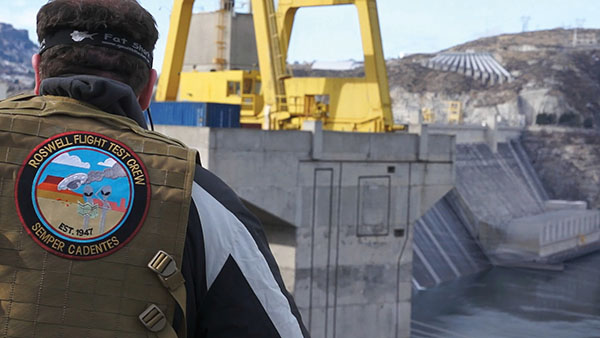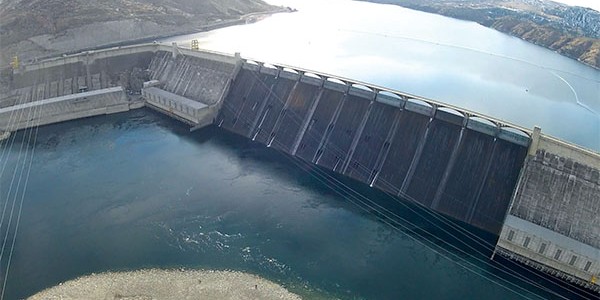First-Person View (FPV) flying is fun, but flying over a unique location can be a once-in-a-lifetime experience, documented with high-definition video that you can share with the world on YouTube and other social media sites.
It’s also an amazing rush, and an experience I’ve been fortunate to have on several occasions as part of the Roswell Flight Test Crew. However, should you be thinking of documenting locations and landmarks, be aware there is a right way and a wrong way to go about it. The wrong way is easy: just follow the example of a self-styled “aerial anarchist” who has gained a fair measure of notoriety on the Internet — roll up on site, unpack your gear, and put a bird in the air.
 Above: From a perch below the Grand Coulee Dam on the east bank of the Columbia River, the Roswell Flight Test Crew launches FPV multirotors to gain an aerial perspective on the massive concrete edifice, built over nine years starting in 1933.
Above: From a perch below the Grand Coulee Dam on the east bank of the Columbia River, the Roswell Flight Test Crew launches FPV multirotors to gain an aerial perspective on the massive concrete edifice, built over nine years starting in 1933.
I’m sure that’s a lot of fun, but it also has the potential to get you into some serious trouble and, it is ultimately very destructive to our entire hobby: all of us lose when flight restrictions are put in place because of the poor judgment of a few rogue operators.
About dam time
Doing it the right way entails considerably more time and effort, but it has one key advantage: you won’t get that hollow feeling in your chest when people with badges walk up to your ground station.
As an example, let’s take a closer look of an excursion to the Grand Coulee Dam in eastern Washington State.
Constructed between 1933 and 1942 as part of Franklin Delano Roosevelt’s “New Deal,” the Grand Coulee provided electricity to smelt aluminum during WW II. With the addition of a third powerhouse back in 1974, Grand Coulee became the most powerful electric-generating plant in the U.S., with a peak output of more than 6,800 megawatts. It’s an amazing place: awe-inspiring scale, a rich history – heck, Woody Guthrie even wrote a song about it!
 Above: From a rocky outcropping at Crown Point State Park, the Roswell Flight Test Crew takes in a panoramic view of the Grand Coulee Dam and the desolate landscape that surrounds it.
Above: From a rocky outcropping at Crown Point State Park, the Roswell Flight Test Crew takes in a panoramic view of the Grand Coulee Dam and the desolate landscape that surrounds it.
With all that going for it, who wouldn’t want to fly over the Grand Coulee Dam? Of course, before you even contemplate flying over such a major landmark, your FPV operations need to be air-tight: razor-sharp piloting skills, a proven aircraft with many hundreds of successful flights, reliable video and telemetry links, a seasoned spotter who is at least as skilled as you are on the sticks and, a ham radio license tucked inside your wallet.
Flying over a billion dollars of critical infrastructure is not an appropriate moment to test a new aircraft or try out a different video transmitter, much less to disregard fundamental safety procedures, like having a qualified spotter at your side.
 Above: Patrick Sherman and Brian Zvaigzne explore the potential beneficial applications of rotordrone technology, give public demonstrations, and share their adventures online.
Above: Patrick Sherman and Brian Zvaigzne explore the potential beneficial applications of rotordrone technology, give public demonstrations, and share their adventures online.
Do your homework
A successful flight over a landmark begins weeks or even months before you actually arrive at the site. You will need to make contact with whomever is responsible for the location or the facility and ask for their permission — and this can be a time-consuming process. Often, such sites are governed by large bureaucracies, and it can take them a long time to process a novel request. Calling the day before you head out to go flying is almost certain to get you a negative response.
I usually start by reaching out to the person or department responsible for communicating with the public – typically the Public Information Officer or a Public Affairs Officer. For a private organization, look for the media contact or someone in the Marketing department.This person will not be the one who ultimately decides whether or not you will be allowed to fly, but he or she can be a powerful ally if you can persuade him or her that you are a safe and responsible operator.
 Above: With a crane visible in the background, a Roswell Flight Test Crew quadcopter maneuvers over the Grand Coulee Dam.
Above: With a crane visible in the background, a Roswell Flight Test Crew quadcopter maneuvers over the Grand Coulee Dam.
It’s tempting to make first contact via email, but by itself, this is unlikely to get you a good outcome. Think about it: you are the secretary who gets all of the emails addressed to “contact@landmark.gov” and there are two messages waiting for you when you get back from lunch.
The first one is from “teacher@localschool.edu,” inquiring about arranging a tour for a group of third graders, the other one is from “lucidity@roswellflighttestcrew.com” and prattles on endlessly about homemade drones and YouTube videos. Which one would you respond to first? Which one would you promptly forget about? I have occasionally made successful first contact via email, but have never flown a noteworthy location without actually talking to someone on the telephone, so expect that is going to be part of the process.
Always take “No” for an answer
You need to be polite, but persistent, to get permission to fly over a significant landmark. Most people outside the hobby have never conceived of FPV flying, and even after you’ve educated them, they will likely regard it as a risky proposition without any tangible benefits. Which newspaper headline do you think the person responsible for the safe operation of a facility, like the Grand Coulee Dam, imagines after hearing your pitch? “Enlightened Dam Manager Allows Local Drone Pilots to Fly; No Incidents Reported ” or “Hobby Drone Crashes into Dam, Blacks Out West Coast; Dam Manager Who Approved Flight Resigns in Disgrace.” Looking at it from that perspective, it becomes a pretty simple decision – doesn’t it?
One technique I’ve employed with some success is showing previous examples of our Roswell Flight Test Crew work. I’ll send along some links to YouTube videos demonstrating how safely and successfully the flights were accomplished in the past. Of course, this does mean taking baby steps along the way to your ultimate goal – and that probably isn’t a bad thing, because it will give you the depth of knowledge and experience you’ll need to be successful when you do get those big opportunities in the future.
 Above: This map, assembled by the Roswell Flight Test Crew using imagery from Google Earth, was submitted to the Public Affairs Office at the Grand Coulee Dam, to illustrate potential launch points for its FPV multirotors during their visit. Only two of these locations were actually approved, and the crew had a strict time window to fly from each location.
Above: This map, assembled by the Roswell Flight Test Crew using imagery from Google Earth, was submitted to the Public Affairs Office at the Grand Coulee Dam, to illustrate potential launch points for its FPV multirotors during their visit. Only two of these locations were actually approved, and the crew had a strict time window to fly from each location.
Finally, be prepared to get bad news. I have heard “No” more often than I’ve heard “Yes.” Sometimes it only takes 30 seconds to get to “No,” and other times it can take months. Either way, it hurts – bear it with grace. Whining only makes you, and the rest of us, look bad.
Temper your expectations
No matter how reliable you make your machine, or how much experience you accumulate, know that there will always be certain locations that will be out of reach. For example: the United States Capitol building. I tried. Trust me, it’s a no-go! Still, you’ll never know unless you try, so go ahead and ask. Realize however, that you may very well be the first FPV rotordrone pilot who has ever made contact with this particular location or facility. Be patient and professional, even if the answer is “No.” Do your best to leave on good terms. You never know: someone might get in touch six months later and give you the nod, because of the positive attitude and trust that you previously built.
This is a delicate moment in the advent of unmanned civil aviation, and it is incumbent on each of us to be good stewards of this new technology and the enormous potential that it has to benefit our society.
By Patrick Sherman



















